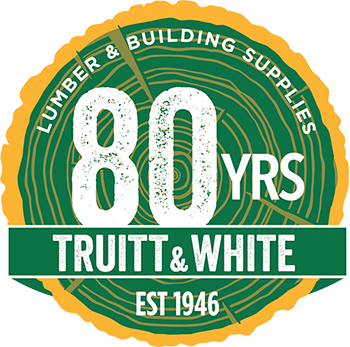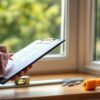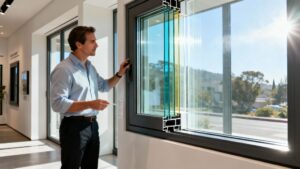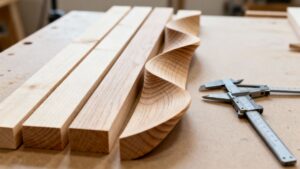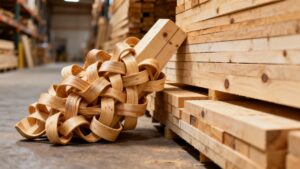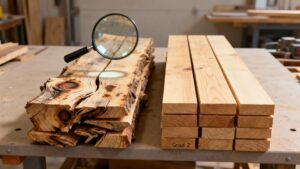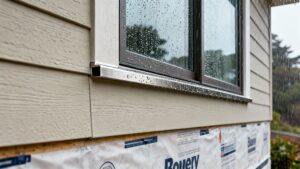When you start looking into the cost of energy-efficient windows for your Bay Area home, you’ll quickly realize there’s no single, simple price. It's an investment, and the goal is to strike the right balance between what you spend upfront and the value you get back over time.
A basic vinyl window might start in the $600-$900 range once installed. On the other hand, premium wood or fiberglass windows from a top-tier brand like Marvin can easily run from $1,500 to over $3,000 per window. The final energy-efficient windows cost is a blend of the materials you choose, the style you want, and the complexity of the installation itself.
Understanding the Value Behind the Energy-Efficient Windows Cost
Choosing new windows for a Bay Area home goes far beyond just picking a design that looks good. It’s a strategic move that directly affects your daily comfort, the overall value of your property, and your monthly energy bills. Think of it like a high-efficiency furnace—the initial sticker price is higher, but you see the returns every month.
This isn't just a niche upgrade anymore; it's becoming the standard for builders and homeowners. The global market for energy-efficient windows hit an impressive USD 22.76 billion in 2024 and is expected to nearly double by 2033, according to the IMARC Group. Modern windows feature double or even triple glazing, low-emissivity (Low-E) coatings, and inert gas fills like argon to stop heat transfer.
Key Factors in Your Window Budget
Whether you're a homeowner in Berkeley or a builder in Oakland, a few core elements will always shape the final cost of your window project:
- Material Quality: The frame material—vinyl, fiberglass, or wood—is one of the most significant cost drivers.
- Glazing Technology: Moving from standard double-pane glass to units with Low-E coatings or argon gas fills increases the price, but it’s where you get a massive performance boost.
- Professional Installation: This isn't the place to cut corners. Expert installation is absolutely essential for the windows to perform as designed and is a major part of the total budget.
- Customization: Non-standard sizes, custom colors, or specific hardware will naturally add to the project's bottom line.
A well-chosen window does more than just fill a hole in a wall—it acts as a thermal shield. It keeps your home warmer during those chilly San Francisco summers and cooler during inland heatwaves, directly lowering your energy consumption.
Estimated Cost Overview for Bay Area Energy Efficient Windows
This table provides a high-level estimate of costs per window, including materials and professional installation, to help with initial project budgeting.
| Window Type / Project Scope | Estimated Cost Range (Per Window, Installed) | Key Considerations |
|---|---|---|
| Standard Vinyl Windows | $600 – $1,200 | Good for budget-conscious projects; offers decent insulation but fewer high-end features. A popular choice from lumberyards near Oakland. |
| High-Performance Vinyl | $900 – $1,600 | Includes upgrades like advanced Low-E coatings and better frame insulation. |
| Fiberglass Windows | $1,200 – $2,500+ | Excellent durability and efficiency; ideal for the Bay Area's varied climate. |
| Wood & Wood-Clad Windows | $1,500 – $3,000+ | Premium aesthetics and strong performance; requires more maintenance unless clad. Perfect for historic Berkeley homes. |
| Full Home Window Replacement | $15,000 – $40,000+ | Total project cost varies widely based on the number of windows, materials, and labor. |
Disclaimer: These are general estimates. For a precise quote from your local Berkeley building materials supplier, an on-site consultation is necessary.
The best way to measure the "cost" is to look at the long-term benefits. To learn more about how these windows perform in our unique local climate, check out our guide on energy-efficient windows for Bay Area homes. It's a forward-thinking upgrade that's proven to enhance your property for years to come.
What Drives Your Final Window Project Cost
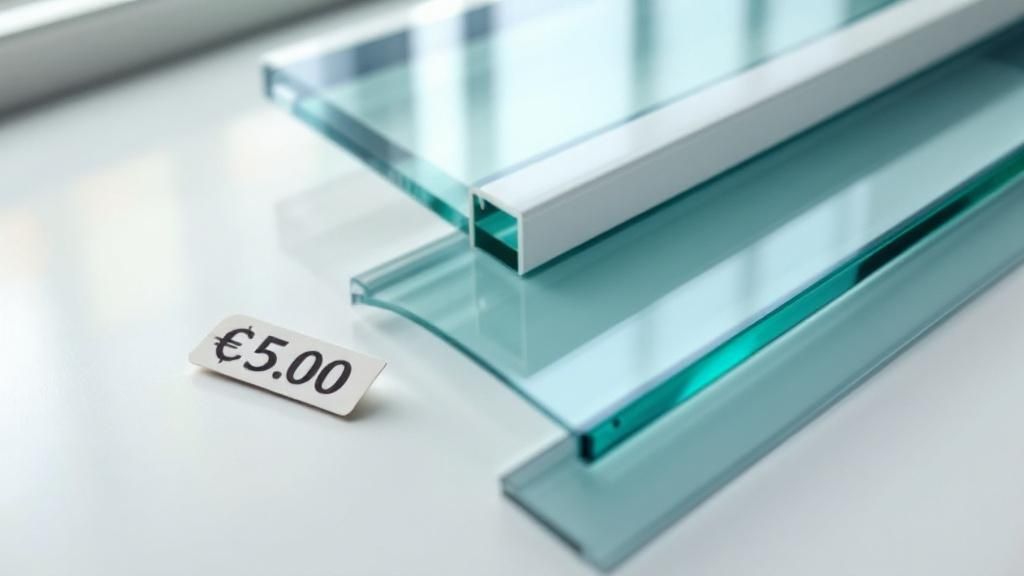
Caption: A modern home in the Bay Area featuring large energy-efficient windows that enhance natural light and reduce cooling costs.
When you budget for new windows, you'll see the price can vary significantly. It’s helpful to know what’s behind those numbers. The final energy-efficient windows cost boils down to the frame material, the glass technology, and any special customizations you choose.
Think of it like planning a custom home build here in the Bay Area. Every material influences the final structure's strength and cost. Making smart choices on your windows ensures you get the best performance for your home, whether it’s a historic Oakland craftsman or a sleek, modern new build.
Frame Material: The Foundation of Your Window
The window frame is the structural backbone of the entire unit. The material you pick is one of the biggest factors driving the price tag, but it also determines durability, maintenance, and its ability to insulate your home against our diverse Bay Area microclimates.
Here’s a look at the most common materials you'll find from top-tier brands like Marvin and Andersen at a quality Bay Area windows and doors supplier:
- Vinyl: A popular, budget-friendly choice offering good insulation and low maintenance, making it a go-to for many residential projects.
- Fiberglass: For exceptional strength and stability, fiberglass is fantastic. It won’t swell or shrink with the Bay Area’s temperature swings, and while it costs more upfront, its longevity is hard to beat.
- Wood and Wood-Clad: Nothing beats the timeless beauty and natural insulation of wood, making it a premium choice for classic Berkeley homes. Wood-clad windows offer a beautiful wood interior protected by a low-maintenance exterior shell.
Glazing Technology: The Engine of Efficiency
If the frame is the window’s body, the glazing is its engine. This is where the "energy-efficient" magic happens. Upgrading your glazing is a direct investment in your home’s comfort and your long-term energy savings.
Think of it this way: a basic double-pane window is a standard car engine. But adding Low-E coatings and gas fills is like upgrading to a high-performance hybrid. It costs more initially but saves you a ton on fuel over the life of the car.
Key glazing upgrades that influence the final price include:
- Low-E Coatings: This is a transparent coating, thinner than a human hair, that reflects heat. In summer, it keeps the sun's heat out; in winter, it keeps your home’s warmth in.
- Gas Fills: The space between glass panes can be filled with a harmless, inert gas like argon. According to the U.S. Department of Energy, windows can be responsible for up to 30% of a home's heating and cooling energy loss—gas fills fight that problem directly.
- Multiple Panes: Upgrading from double-pane to triple-pane glass adds another layer of insulation, dramatically improving energy efficiency and soundproofing, though at a higher cost.
For a more detailed explanation, check out our guide on choosing energy-efficient windows.
Customization and Hardware
Finally, customization is where you can truly make your windows your own and where costs can add up. Unique shapes, custom exterior colors, intricate grid patterns, and premium hardware all contribute to the final price. These details add architectural character but also increase manufacturing complexity and cost.
Benefits of Energy-Efficient Windows in the Bay Area
The Bay Area isn't just one climate; it's a patchwork of microclimates. A window that’s perfect for the sunny heat of Concord might struggle in the foggy, salt-laced air of San Francisco. That’s why picking the right frame material is so important for performance and long-term value.
The classic look of Marvin wood windows is often ideal for preserving the historic character of a Berkeley bungalow. But for a home in Oakland or on the coast, the incredible durability of fiberglass is a smarter bet—it stands up to temperature shifts and salty air without flinching. The key is matching the material’s strengths to your project’s real-world conditions.
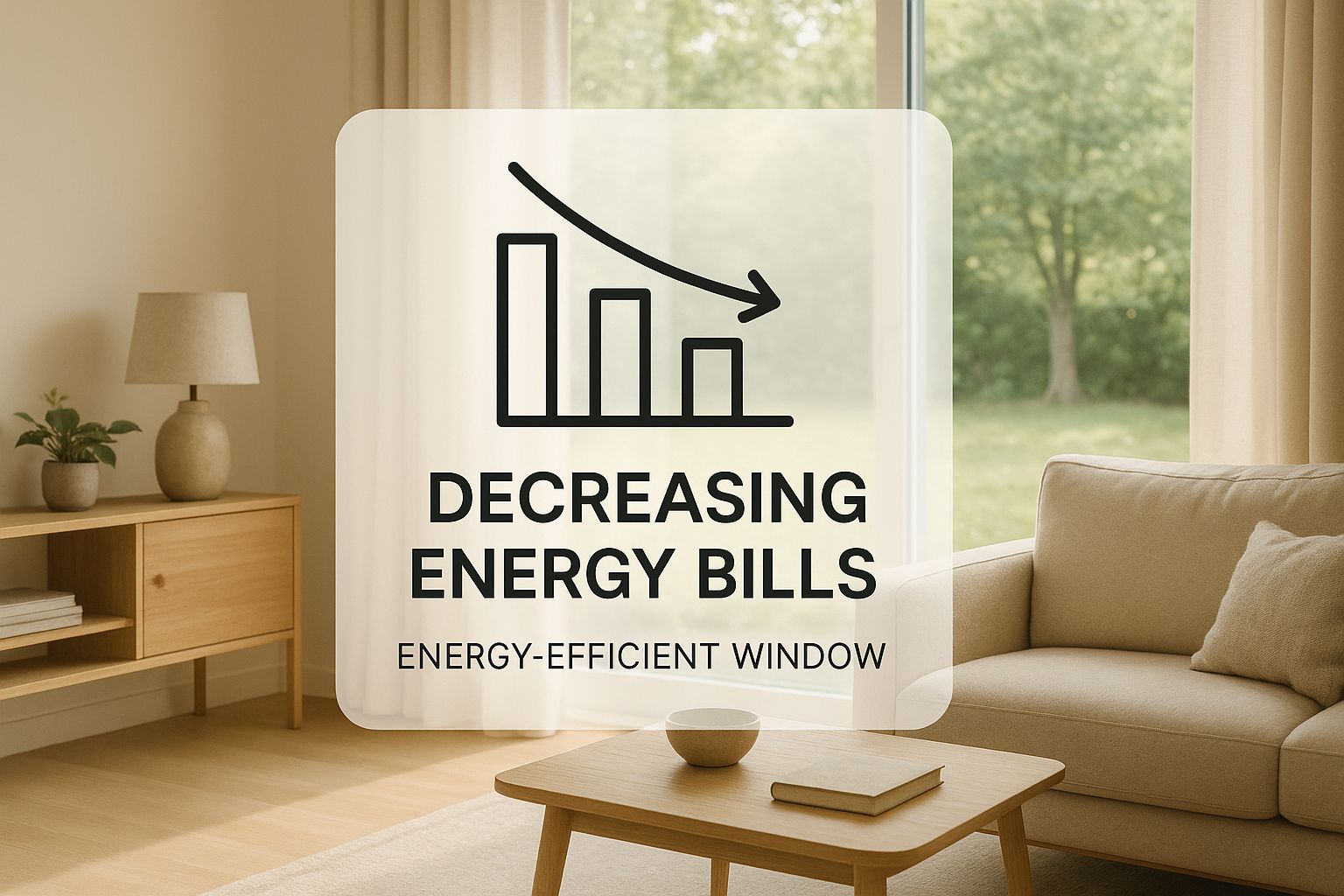
Caption: Chart illustrating the significant potential energy savings from upgrading to high-performance, energy-efficient windows.
As you can see, investing in high-performance windows isn't just an expense; it’s a direct route to lower monthly energy costs. Our guide offers additional considerations when choosing windows and doors.
Window Material Comparison for Bay Area Projects
A window's frame is its first line of defense. It dictates not just the look but also how well the window insulates, how much upkeep it will need, and its fundamental strength. This table compares popular materials we see builders and homeowners choose here at Truitt & White.
| Material | Average Cost | Energy Efficiency | Maintenance Level | Best For |
|---|---|---|---|---|
| Fiberglass | High | Excellent | Low | Homes needing maximum durability and efficiency in variable climates like San Francisco or the East Bay hills. |
| Wood | Highest | Excellent | High (Moderate if clad) | Preserving the aesthetic of historic or traditional homes in neighborhoods like Berkeley and Piedmont. |
| Vinyl | Low-Moderate | Good | Very Low | Budget-conscious new construction or replacement projects where easy upkeep is a top priority. |
| Wood-Clad | High | Excellent | Low | Achieving the warm interior of wood with a weather-resistant exterior, ideal for long-term performance across the Bay Area. |
Each material has a place, but the "best" one always solves your specific problems. Looking at them side-by-side helps you focus on what truly matters for your build or remodel.
Decoding the Energy Performance Label on Your Windows
When you're looking at new windows, you'll see a sticker that looks a bit like a cryptic code. Think of it as the window's nutrition label, giving you a standardized breakdown of its performance. Learning to read this label from the National Fenestration Rating Council (NFRC) is the best way to compare products.
It cuts through marketing fluff and gives you the hard data you need to see if a window meets California's strict Title 24 energy codes and will actually save you money.
Caption: An example of the NFRC label, showing key performance metrics like U-Factor and Solar Heat Gain Coefficient (SHGC).
U-Factor: The Insulation Powerhouse
First up is the U-Factor, which tells you how well a window keeps heat from leaking out. U-Factor ratings generally fall between 0.20 and 1.20. The rule is simple: the lower the U-Factor, the better the window insulates. For anyone in the Bay Area, a low U-Factor is a must for keeping your home cozy.
Solar Heat Gain Coefficient (SHGC): Your Window's Built-in Sunglasses
Next is the Solar Heat Gain Coefficient (SHGC). This metric tells you how much of the sun’s heat the window blocks. SHGC is rated on a scale from 0 to 1. Just like with U-Factor, the lower the SHGC, the less heat the window allows inside.
In sun-drenched parts of the Bay Area, the California Energy Commission recommends a low SHGC (ideally 0.25 or less) to stop your home from overheating. This is what keeps your AC from working overtime.
The demand for high-performance windows isn't just a local trend. According to global market trends from Precedence Research, the market was valued at USD 16.34 billion in 2024 and is projected to more than double by 2034, fueled by tougher energy codes.
These ratings are essential for complying with California's Title 24 standards. Choosing windows with the right U-Factor and SHGC means you're investing in long-term comfort and real energy savings.
Calculating the Return on Your Window Investment
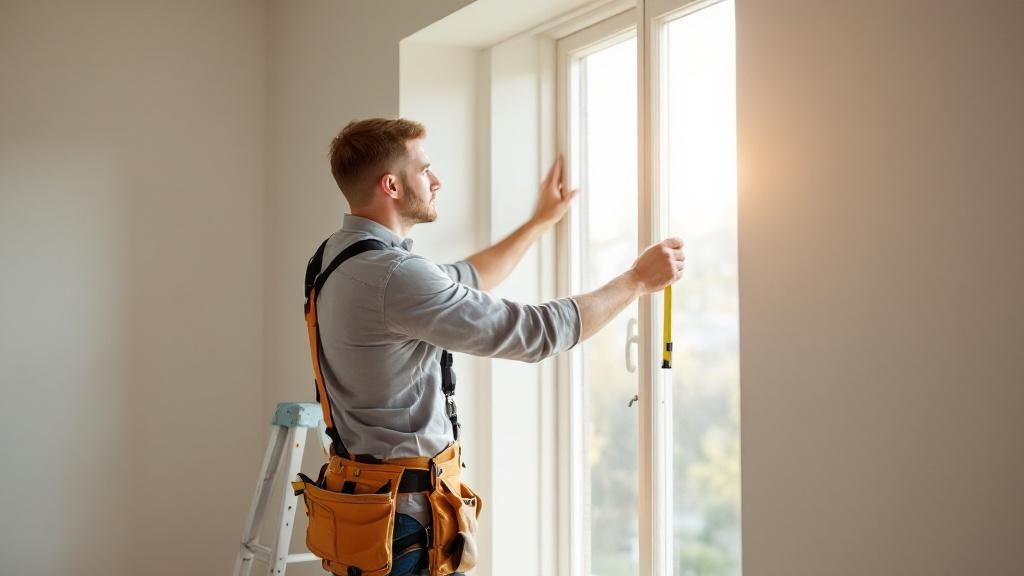
Caption: A comfortable, light-filled living room, showcasing the improved ambiance and value added by new, energy-efficient windows.
Let's talk about what you get back when you invest in high-performance windows. The true value unfolds over years of savings and increased home value. The logic behind a kitchen renovation return on investment applies here—you're boosting your home's functionality, appeal, and financial worth.
Estimating Your Energy Savings
The first return you'll notice is a drop in your monthly utility bills. According to ENERGY STAR, homeowners who swap out old single-pane windows for ENERGY STAR certified models can save an average of $101–$583 every year. For a typical Bay Area home, those savings add up fast.
Modern windows create a powerful thermal barrier. This barrier keeps heated air inside during chilly months and deflects the sun's heat during warm summers.
Beyond the Utility Bill: The Soft Returns
The financial perks don't stop there. Several "soft" returns add tremendous value, especially in the competitive Bay Area real estate market.
Upgrading your windows enhances more than just your home’s efficiency. It improves your quality of life by creating a more comfortable, quiet, and valuable living space.
These less obvious benefits can have a huge impact:
- Enhanced Indoor Comfort: High-performance windows get rid of cold drafts and hot spots, giving you a consistently comfortable temperature all year long.
- A Quieter Home: The same features that make windows energy-efficient—like double or triple panes—are also fantastic at blocking outside noise from a bustling Oakland or San Francisco neighborhood.
- Increased Property Value: New windows boost curb appeal and send a clear message to buyers that your home is well-maintained and efficient, often translating to a higher resale price.
Factoring in Rebates and Tax Credits
Be sure to look into federal, state, and local utility programs. Many offer rebates and tax credits for installing certified energy-efficient windows. These incentives can dramatically cut down the payback period. Always check with the California Energy Commission and your local utility provider for current programs.
Budgeting Your Project and Partnering with Experts
A new set of windows is a major project, and the total energy efficient windows cost can feel daunting. You can replace every window at once or phase the project room by room. Thinking about the bigger picture of renovating a property on a budget can provide helpful strategies.
No matter which path you choose, don't skimp on professional installation. A top-of-the-line window installed poorly is nothing more than an expensive pane of glass. It simply won't perform as designed.
The Critical Role of Expert Installation
Expert installation is the final, essential piece of the puzzle. A professional ensures proper sealing and fitting, eliminating drafts and blocking moisture. This not only protects your investment but also keeps the manufacturer's warranty intact.
The demand for these windows is exploding. Valued at USD 15.1 billion in 2024, the global market is growing as more people recognize the long-term savings. Learn more about this growing market.
The specialists at Truitt & White can guide you through every step. We have strong relationships with trusted local installers and can connect builders, contractors, and homeowners with the right pros for the job. We’ll help you get clear, accurate quotes to ensure your project stays on budget.
Ready to start planning? Visit our Berkeley showroom to see fantastic products from Marvin and Andersen and get personalized advice from our team.
Frequently Asked Questions (FAQs)
Here are straightforward answers to questions we often hear from builders, architects, and homeowners in the Bay Area.
1. Are triple-pane windows worth the cost in the Bay Area?
For most Bay Area homes, high-performance double-pane windows with modern Low-E coatings offer the best balance of cost and performance. While triple-pane windows provide superior soundproofing, their extra thermal insulation often isn't necessary for our mild climate and may not provide a strong return on investment.
2. How much of my budget should I allocate for installation?
Professional installation is critical and typically accounts for 30% to 50% of your total window project budget. Think of this not as a labor fee but as an insurance policy that ensures your windows perform as designed, preventing leaks and preserving the manufacturer's warranty.
3. Are there rebates for installing energy-efficient windows in California?
Yes, absolutely. Federal, state, and local programs often offer tax credits or direct rebates for installing ENERGY STAR certified windows. Before purchasing, check with the California Energy Commission and your local utility provider for the most up-to-date information on available incentives.
4. How long do new energy-efficient windows last?
The lifespan depends on the frame material and construction quality. High-end fiberglass or wood-clad windows from a top brand like Marvin can last 30 to 50 years or more with proper care, while quality vinyl windows typically have a lifespan in the 20 to 30-year range.
5. What is the single biggest mistake to avoid when buying new windows?
The biggest mistake is focusing only on the window's price while ignoring the quality of the installation. A premium window installed poorly will leak air, fail prematurely, and cost you more in wasted energy. Recognizing the thirteen signs it's time to replace your windows and doors is the first step toward making a smart investment in both product and installation.
For expert guidance and to explore the best Bay Area windows and doors for your project, contact the team at Truitt & White. We can connect you with trusted installers and provide precise quotes from our Berkeley building materials showroom. Visit our Berkeley showroom for expert advice.

